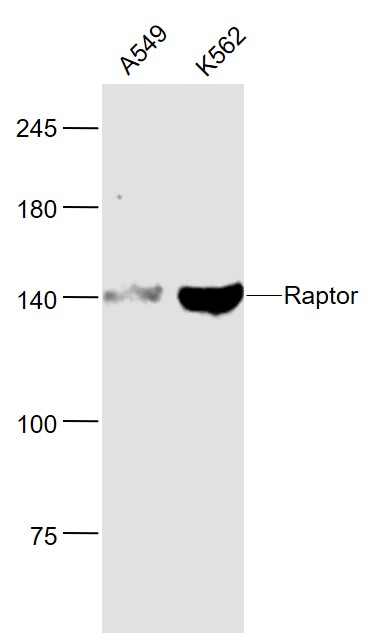
Mouse Anti-Raptor antibody
RPTOR; p150 target of rapamycin (TOR) scaffold protein containing WD repeats; P150 target of rapamycin (TOR)-scaffold protein; Regulatory Associated Protein of mTOR; KIAA1303; RPTOR_HUMAN; Regulatory-associated protein of mTOR; p150 target of rapamycin (T
View History [Clear]
Details
Product Name Raptor Chinese Name mTOR相关调控蛋白单克隆抗体 Alias RPTOR; p150 target of rapamycin (TOR) scaffold protein containing WD repeats; P150 target of rapamycin (TOR)-scaffold protein; Regulatory Associated Protein of mTOR; KIAA1303; RPTOR_HUMAN; Regulatory-associated protein of mTOR; p150 target of rapamycin (TOR)-scaffold protein. Research Area Tumour immunology Signal transduction Apoptosis transcriptional regulatory factor Immunogen Species Mouse Clonality Monoclonal Clone NO. 7G4 React Species Human, (predicted: Mouse, Rat, ) Applications WB=1:500-1000 ELISA=1:5000-10000
not yet tested in other applications.
optimal dilutions/concentrations should be determined by the end user.Theoretical molecular weight 147kDa Cellular localization cytoplasmic Form Liquid Concentration 1mg/ml immunogen Recombinant human Raptor protein Lsotype IgG1 Purification affinity purified by Protein G Buffer Solution 0.01M TBS(pH7.4) with 1% BSA, 0.03% Proclin300 and 50% Glycerol. Storage Shipped at 4℃. Store at -20 °C for one year. Avoid repeated freeze/thaw cycles. Attention This product as supplied is intended for research use only, not for use in human, therapeutic or diagnostic applications. PubMed PubMed Product Detail mTOR controls cell growth, in part by regulating p70 S6 kinase alpha (p70alpha) and eukaryotic initiation factor 4E binding protein 1 (4EBP1). Raptor is a 150 kDa mTOR binding protein that also binds 4EBP1 and p70alpha. The binding of Raptor to mTOR is necessary for the mTOR-catalyzed phosphorylation of 4EBP1 in vitro, and it strongly enhances the mTOR kinase activity toward p70alpha. Rapamycin or amino acid withdrawal increases, whereas insulin strongly inhibits, the recovery of 4EBP1 and raptor on 7-methyl-GTP Sepharose. Partial inhibition of raptor expression by RNA interference (RNAi) reduces mTOR-catalyzed 4EBP1 phosphorylation in vitro. RNAi of C. elegans raptor yields an array of phenotypes that closely resemble those produced by inactivation of Ce-TOR. Thus, raptor is an essential scaffold for the mTOR-catalyzed phosphorylation of 4EBP1 and mediates TOR action in vivo.
Function:
Involved in the control of the mammalian target of rapamycin complex 1 (mTORC1) activity which regulates cell growth and survival, and autophagy in response to nutrient and hormonal signals; functions as a scaffold for recruiting mTORC1 substrates. mTORC1 is activated in response to growth factors or amino-acids. Growth factor-stimulated mTORC1 activation involves a AKT1-mediated phosphorylation of TSC1-TSC2, which leads to the activation of the RHEB GTPase that potently activates the protein kinase activity of mTORC1. Amino-acid-signaling to mTORC1 requires its relocalization to the lysosomes mediated by the Ragulator complex and the Rag GTPases. Activated mTORC1 up-regulates protein synthesis by phosphorylating key regulators of mRNA translation and ribosome synthesis. mTORC1 phosphorylates EIF4EBP1 and releases it from inhibiting the elongation initiation factor 4E (eiF4E). mTORC1 phosphorylates and activates S6K1 at 'Thr-389', which then promotes protein synthesis by phosphorylating PDCD4 and targeting it for degradation.
Subunit:
Interacts with MTOR (By similarity). Part of the mammalian target of rapamycin complex 1 (mTORC1) which contains MTOR, MLST8, RPTOR and AKT1S1. mTORC1 binds to and is inhibited by FKBP12-rapamycin. Binds directly to 4EBP1 and RPS6KB1 independently of its association with MTOR. Binds preferentially to poorly or non-phosphorylated forms of EIF4EBP1, and this binding is critical to the ability of MTOR to catalyze phosphorylation. Forms a complex with MTOR under both leucine-rich and -poor conditions. Interacts with ULK1 in a nutrient-dependent manner; the interaction is reduced during starvation. Interacts (when phosphorylated by AMPK) with 14-3-3 protein, leading to inhibit its activity.
Subcellular Location:
Cytoplasm. Lysosome. Note=Targeting to lysosomes depends on amino acid availability.
Tissue Specificity:
Highly expressed in skeletal muscle, and in a lesser extent in brain, lung, small intestine, kidney and placenta.
Post-translational modifications:
In response to nutrient limitation, phosphorylated by AMPK; phosphorylation promotes interaction with 14-3-3 proteins, leading to negative regulation of the mTORC1 complex. In response to growth factors, phosphorylated at Ser-719, Ser-721 and Ser-722 by RPS6KA1; phosphorylation positively stimulates mTORC1 activity.
Similarity:
Belongs to the WD repeat RAPTOR family.
Contains 7 WD repeats.
SWISS:
Q8N122
Gene ID:
57521
Database links:Entrez Gene: 57521 Human
Entrez Gene: 74370 Mouse
Omim: 607130 Human
SwissProt: Q8N122 Human
SwissProt: Q8K4Q0 Mouse
Unigene: 133044 Human
Unigene: 209933 Mouse
Unigene: 98539 Rat
Product Picture
References (0)
No References
Bought notes(bought amounts latest0)
No one bought this product
User Comment(Total0User Comment Num)
- No comment



 +86 571 56623320
+86 571 56623320
 +86 18668110335
+86 18668110335

